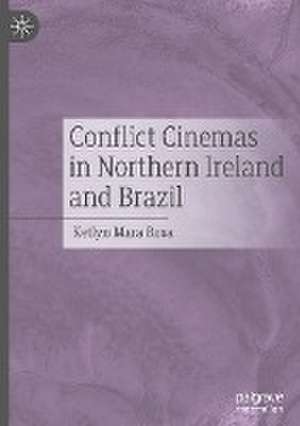Conflict Cinemas in Northern Ireland and Brazil
Autor Ketlyn Mara Rosaen Limba Engleză Hardback – 20 iul 2023
Preț: 727.00 lei
Preț vechi: 886.59 lei
-18% Nou
Puncte Express: 1091
Preț estimativ în valută:
139.15€ • 143.40$ • 117.47£
139.15€ • 143.40$ • 117.47£
Carte tipărită la comandă
Livrare economică 03-17 martie
Preluare comenzi: 021 569.72.76
Specificații
ISBN-13: 9783031346972
ISBN-10: 3031346971
Pagini: 217
Ilustrații: XI, 217 p. 8 illus., 7 illus. in color.
Dimensiuni: 148 x 210 mm
Greutate: 0.43 kg
Ediția:1st ed. 2023
Editura: Springer International Publishing
Colecția Palgrave Macmillan
Locul publicării:Cham, Switzerland
ISBN-10: 3031346971
Pagini: 217
Ilustrații: XI, 217 p. 8 illus., 7 illus. in color.
Dimensiuni: 148 x 210 mm
Greutate: 0.43 kg
Ediția:1st ed. 2023
Editura: Springer International Publishing
Colecția Palgrave Macmillan
Locul publicării:Cham, Switzerland
Cuprins
1. Introduction.- 2. Unspeakable acts: embodiment and perception in Bloody Sunday and ‘71.- 3. Embodied violation in Tropa de Elite and A Divisão: the spectacle of torture and violence in Rio’s favelas.- 4. Corporeal navigation of carceral spaces in Northern Ireland: the sensorial geography of limitation in Maze and Silent Grace.- 5. Marginalized bodies and violated senses: representations of inhumane confinement in Carandiru and Quase Dois Irmãos.- 6. Final Thoughts.
Notă biografică
Ketlyn Mara Rosa holds a Doctoral Degree from the Federal University of Santa Catarina, Brazil, and an IRC postdoctoral fellowship at the Film Department at Trinity College Dublin, Ireland. Her research addresses questions of embodied violence in film and she has published in several Brazilian and international academic journals.
Textul de pe ultima copertă
This book focuses on the analysis of sensorial representations of violent images in contemporary films that portray embodied violation in urban environments of street clashes and prisons in Northern Ireland and Brazil during the late twentieth century. There is an emphasis on the representation of senses and how they play a significant role in structuring narratives and mapping the cinematic landscapes of conflict. Whether on the streets and prisons of Belfast, Derry, São Paulo or Rio, the attention is on the endangered body and its fragility or strength. Analyzing films through the novel framework of sensorial perspective enables the understanding of urban and prison landscapes as part of a somatic geography that affects the corporeal engagement of the participants. As a multicultural study, this is an essential book for those interested in the relationship between cinema and history while taking into consideration the interactive roles of the senses and perception.
Caracteristici
Bridges between Northern Irish and Brazilian Cinema Analyses cinematic violence based on sensorial perception Foregrounds the corporeal immersion during violent conflicts
